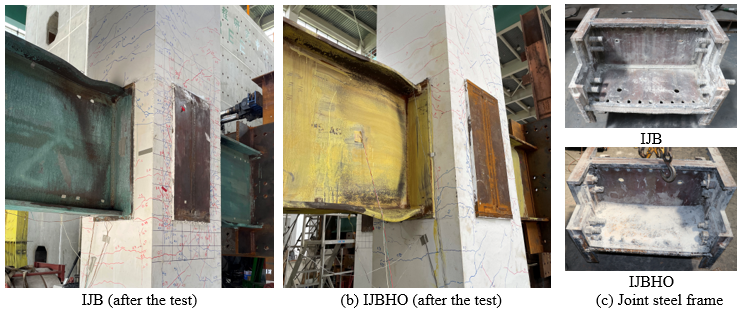Abstract
Reinforced Concrete column and Steel beam (RCS) structural systems have recently become popular in Taiwan for office buildings. High seismic demand makes the size of conventional concrete columns enormous and the reinforcement over-crowded, which can be solved using high-strength materials. However, due to the lacuna of research regarding the usage of high-strength materials, existing design guidelines for the RCS systems have restricted the maximum grade of steel reinforcement to 410 MPa. Also, using high-strength materials in RCS joints necessitates innovative joint detailing and design to develop sufficient joint bearing and shear strength. Thus, a new high-strength reinforced concrete column and steel beam (New-RCS) joint was developed in this study, incorporating the use of Grade 690 MPa steel as reinforcement along with Grade 84 MPa concrete. A combination of wide flange bearing plate and flange doubler plate joint detailing was developed to improve the bearing and shear capacity of the joint. Also, a design methodology based on moment-curvature analysis was proposed to include the contribution of locked longitudinal reinforcement to bearing resistance. Subsequently, two large-scale interior beam-column subassemblies were subjected to quasi-static cyclic loading to verify the seismic behaviour of the proposed joint. One specimen was designed explicitly considering the material hardening and overstrength of steel beams. While the other was designed following the Taiwanese practice, which does not explicitly consider material hardening and overstrength but implicitly does it through strength reduction factors. Both the specimens exhibited a drift capacity of 4% with a stable and ductile hysteretic response and eventually failed through beam plastic hinging.(土木系歐昱辰教授提供)
Highlights
- The first study in literature where high-strength longitudinal reinforcement ( fy=690 MPa) has been used in the design of RCS Joint.
- Development of innovative joint detailing and design to enhance the joint bearing and shear capacity.
- Design methodology to estimate the contribution of locked longitudinal rebars towards joint bearing strength,
- Experimental testing of two large-scale interior RCS beam-column joint specimen subassemblies.
Proposed Joint Design

Fig. 1. Proposed joint design: a) steel framing of the joint with weld details before the attachment of flange doubler plate (FDP), and b) proposed joint.
Performance of proposed joints under displacement-controlled quasi-static cyclic loading

Fig. 3. State of test specimens at the end of the test (4% drift): a) IJB, b) IJBHO, and c) joint steel frame. Both specimens exhibited flexural beam hinging, while the joint and column were capacity protected as intended in design and desired for a good seismic response.